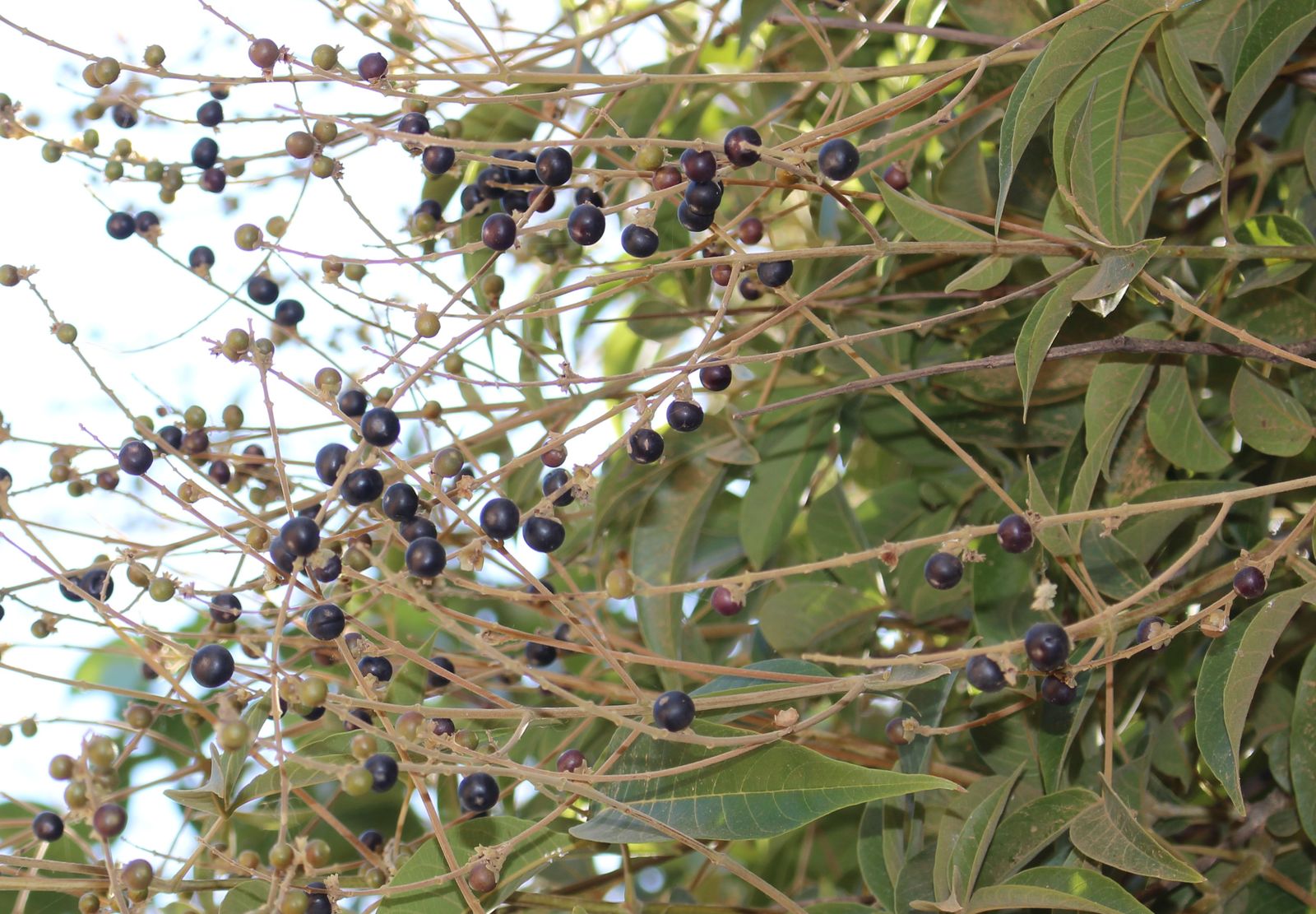Vitex altissima.

|
|
Vitex altissima Common Name: Peacock chaste tree Scientific
Classification Kingdom: Plantae Phylum: Tracheophyta Class: Magnoliopsida Order: Lamiales Family: Lamiaceae Genus: Vitex Species: V. altissima Synonyms: Vitex
alata Willd., Vitex appendiculata Rottler ex C.B.Clarke, Vitex latifolia Wight
ex Steud., Vitex zeylanica Turcz. Morphological Description Vitex altissima,
commonly known as the peacock chaste tree, is a large deciduous tree growing
20–40 m tall, with a trunk diameter up to 1.5 m. Its distinguishing features
include: · Bark: Greyish, smooth when young, becoming scaly and fissured with
age · Leaves: Trifoliolate or palmate, opposite, with 3–5 elliptic or
elliptic-lanceolate leaflets (7–15 cm long, 3–6 cm wide), acuminate apex,
cuneate base, serrate margins, and pubescent undersides · Flowers: Bluish-white, 5–7 mm across, in dense terminal panicles
(15–25 cm long), blooming from February to May · Fruit: Purplish-black drupes, 4–6 mm in diameter, four-seeded,
ripening from June to September The tree’s dense,
spreading crown and vibrant flowers make it visually striking in forest
settings (Fern, 2024). Distribution and Habitat Vitex altissima is
native to the Indomalayan realm, occurring in Bangladesh, India (Eastern Ghats,
Deccan Plateau), Indonesia, Myanmar, Sri Lanka, and New Guinea. It thrives in: · Evergreen Forests: At elevations of 0–1,200 m, on loamy or
clayey soils with pH 5.5–7.0 · Deciduous Forests: In areas with annual rainfall of 800–2,000
mm, tolerating dry spells · Disturbed Areas: Along forest edges and riverbanks, showing
resilience to moderate disturbance It is occasionally
planted in tropical regions for timber or ornamental purposes, adapting to
temperatures of 10–35°C but sensitive to frost (Kew Science, n.d.). Ethnopharmacology Vitex altissima is
widely used in traditional medicine, particularly in Ayurvedic and Siddha
systems in India and Sri Lanka. Ethnopharmacological studies confirm several
applications: · Antioxidant Activity: Ethyl acetate leaf extracts yield six
iridoids (e.g., 6′-O-trans-caffeoylnegundoside), showing strong DPPH
radical-scavenging (IC₅₀ 15–25 μg/mL) and superoxide free-radical-scavenging
activity, supporting use for inflammation and oxidative stress-related
conditions like rheumatism (Sridhar et al., 2004). · Antimicrobial Activity: Hydro-alcoholic leaf extracts inhibit
Gram-positive (Staphylococcus aureus, MIC 250 μg/mL) and Gram-negative bacteria
(Escherichia coli, MIC 500 μg/mL), validating use for wound healing,
stomatitis, and skin infections (Leela et al., 2020). · Anti-inflammatory and Analgesic: Methanolic leaf extracts (200 mg/kg)
reduce carrageenan-induced paw edema in rats by 40%, supporting traditional use
for rheumatic swellings and post-childbirth pain (Manjunatha et al., 2007). · Worm Infestation: Bark decoctions exhibit anthelmintic
activity against Pheretima posthuma (paralysis at 50 mg/mL), supporting use for
intestinal parasites (Leela et al., 2020). Phytochemical analyses
reveal iridoids (e.g., agunoside, negundoside), flavonoids (e.g.,
2-o-hydroxybenzoylorientin), lignans (altisonin), and sesquiterpenoids,
contributing to its bioactivity. GC-MS identifies n-hexadecanoic acid and
squalene, linked to antimicrobial and anticancer properties (Rao et al., 2015). ⚠ Toxicity Profile: No acute toxicity is reported for Vitex
altissima at therapeutic doses. However, high doses of leaf extracts (above
1,000 mg/kg in rats) may cause mild hepatotoxicity, indicated by elevated liver
enzymes. Prolonged use or high doses should be avoided, especially in
individuals with liver conditions. Skin sensitization is possible with topical
use due to iridoids. Consultation with a qualified practitioner is recommended,
particularly for pregnant or breastfeeding individuals (Leela et al., 2020). Additional Uses · Timber: The wood, with a density of 700–850 kg/m³, is durable and
termite-resistant, used for construction, furniture, cabinetry, and cart axles
(Fern, 2024). · Dye: A yellow dye extracted from the wood is used traditionally,
though rarely commercially (Fern, 2024). · Ecological Role: The tree supports pollinators (e.g., bees)
with nectar-rich flowers and provides habitat for birds and small mammals in
forest ecosystems (Kew Science, n.d.). · Ornamental: Planted in tropical gardens for its attractive foliage and
flowers, though less common than Vitex agnus-castus (Wikipedia contributors,
2024). References
External Links More Pictures |
|
| Compounds of Vitex altissima. | |
| References | Murtala Muhammad, Etal. (2023). Phytochemical analysis of Nigerian medicinal plants. NMPP-DB Project, Department of Biochemistry, Kano University of Science and Technology, Wudil |